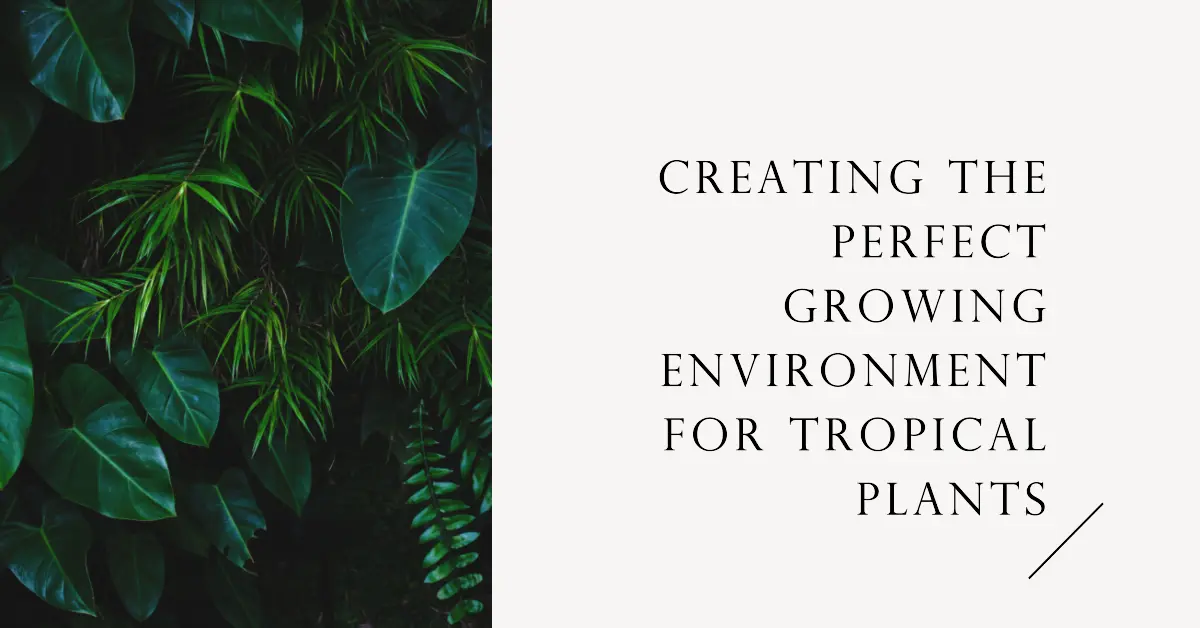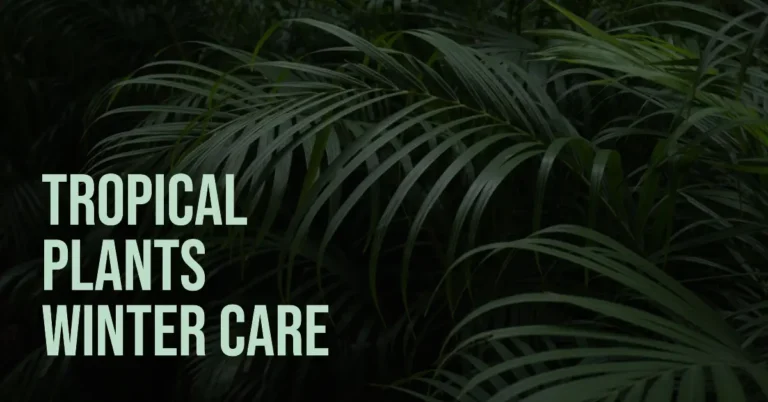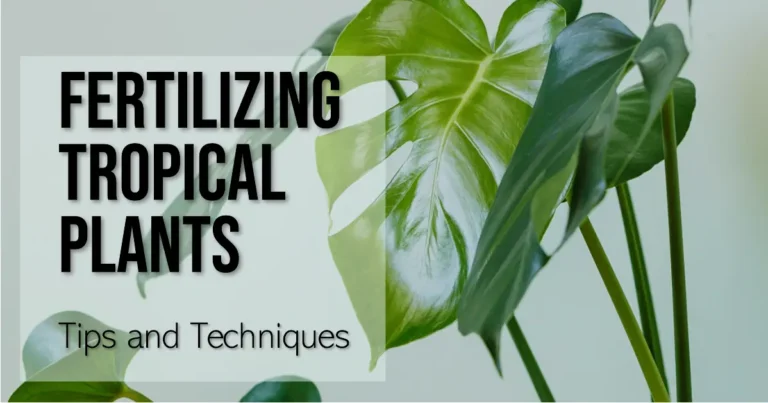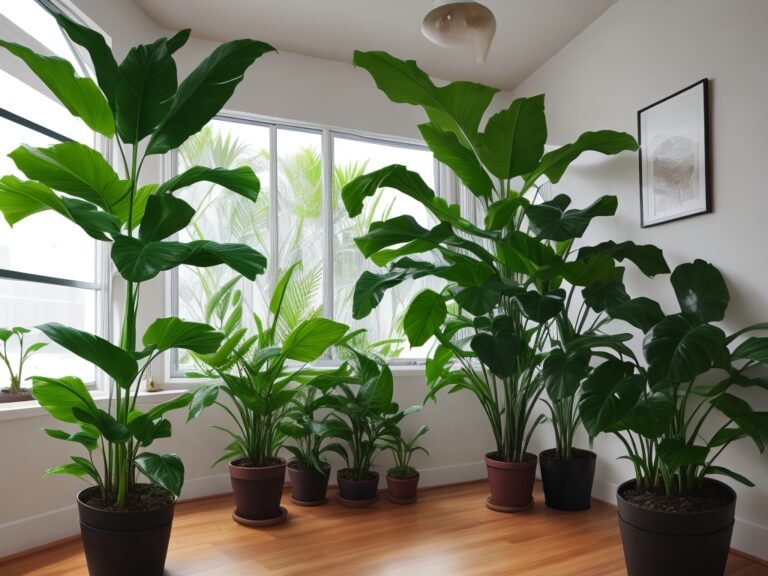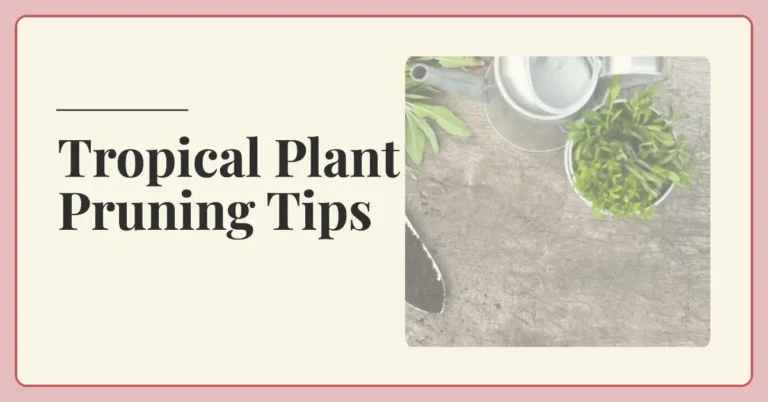Tropical Plant Soil: How to Create the Perfect Growing Environment
I am excited to share with you my knowledge about tropical plant soil. Tropical plants are known for their vibrant colors, unique textures, and exotic beauty. However, their beauty is not just skin deep. The soil these plants grow in plays a crucial role in their overall health and growth. In this article, I will guide you through the basics of tropical plant soil, its importance, and how to care for it.
Understanding tropical plant soil is essential for any gardener or plant enthusiast who wants to grow these plants successfully. The soil in tropical regions is different from that in other parts of the world. It is generally acidic, rich in organic matter, and has a high water-holding capacity. The soil’s acidity is due to the high rainfall and warm temperatures, which cause the rapid decomposition of organic matter, releasing acids into the soil. Additionally, the high water-holding capacity is due to the soil’s clay content, which helps to retain moisture. In the following sections, we will explore the importance of climate and geography, the types of tropical plants and their soil requirements, and the role of biodiversity in tropical soils.
Key Takeaways
- Understanding the basics of tropical plant soil is essential for successful plant growth.
- The soil in tropical regions is generally acidic, rich in organic matter, and has a high water-holding capacity.
- The importance of climate and geography, the types of tropical plants and their soil requirements, and the role of biodiversity in tropical soils are all crucial factors to consider when growing tropical plants.
Understanding Tropical Plant Soil
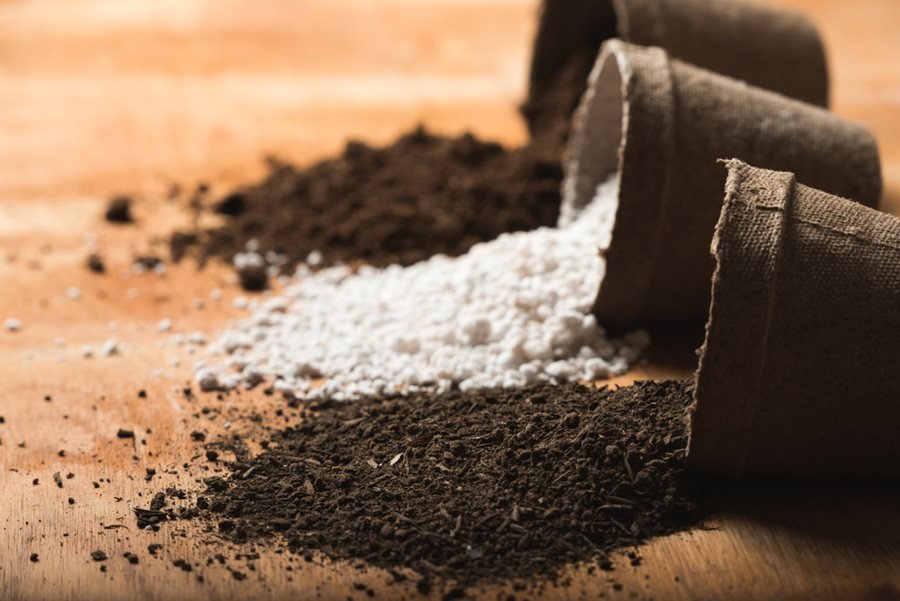
As someone who has studied tropical plant soil, I can tell you that it is a complex and fascinating topic. In this section, I will discuss the characteristics of tropical soil and its structure and composition.
Characteristics of Tropical Soil
Tropical soil is found in areas with high temperatures and rainfall, such as rainforests. It is characterized by its high fertility, but also by its vulnerability to erosion. The soil is often shallow and low in organic matter, which means that it can be easily washed away by heavy rains.
Tropical soil is also highly weathered, which means that it has undergone a lot of physical and chemical changes over time. This weathering process is caused by the high temperatures and humidity in tropical regions, which break down parent material into smaller particles. This process can take thousands of years, and the result is a soil that is very different from the original parent material.
Soil Structure and Composition
The structure and composition of tropical soil is determined by a number of factors, including parent material, physical properties, and chemical properties. The physical properties of soil include things like texture, structure, and porosity, while the chemical properties include things like pH, nutrient content, and cation exchange capacity.
Tropical soil is often composed of a mixture of sand, silt, and clay particles, with varying proportions depending on the specific location. The soil structure is also influenced by the amount of organic matter present, which can help to improve soil fertility and structure.
In conclusion, understanding tropical plant soil is crucial for anyone interested in tropical agriculture or ecology. By understanding the characteristics of tropical soil and its structure and composition, we can better manage and protect these important ecosystems.
Importance of Climate and Geography
Impact of Climate on Tropical Soil
As a tropical plant soil writer, I understand that climate is a critical factor in soil formation. The tropical regions located near the equator have a warm and humid climate that encourages the growth of diverse vegetation, leading to the development of nutrient-poor soil. The tropical rainforest biome, for instance, experiences high annual rainfall, which leaches nutrients from the soil, making it unsuitable for agriculture.
Moreover, climate influences the rate of weathering, erosion, and organic matter decomposition, which are crucial soil-forming processes. For instance, high temperatures and rainfall increase biological activity and metabolic rates in the soil, leading to faster decomposition rates.
Geological Phenomena and Soil Formation
Geological phenomena such as plate tectonics, mountain ranges, volcanic outputs, and oceanic submergence also play a significant role in soil formation. The Andes, for example, is a major geologic phenomenon in South America that has influenced the formation of various soil types. Volcanic activity in the Andes has led to the deposition of volcanic ash, which has resulted in the formation of andepts, a type of soil that is rich in minerals and organic matter.
The type of volcanic output also influences the type of soil that forms. For instance, andesitic and rhyolitic volcanic outputs lead to the formation of andosols, which are characterized by high nutrient content and water-holding capacity.
In conclusion, as a tropical plant soil writer, I understand that climate and geologic phenomena are critical factors in soil formation. The warm and humid climate in tropical regions encourages the growth of diverse vegetation, leading to nutrient-poor soil. Geological phenomena such as volcanic activity and plate tectonics also influence the formation of various soil types.
Tropical Plant Types and Their Soil Requirements
Common Tropical Houseplants
Tropical houseplants are a great addition to any home. They bring a touch of the exotic to your living space and can improve the air quality in your home. Some of the most popular tropical houseplants include monstera, orchids, pothos, alocasia, bromeliads, philodendron, croton, spider plant, Chinese evergreen, peperomia, peace lily, ZZ plants, ferns, dracaena, ficus lyrata, fiddle leaf fig, and Swiss cheese plant.
Soil Requirements for Specific Tropical Plants
When it comes to soil requirements, tropical plants are quite specific. Understanding the soil requirements of your tropical plants is essential to their growth and overall health. Here are some soil requirements for specific tropical plants:
Monstera
Monstera plants prefer well-draining soil that is slightly acidic. They also require a good balance of moisture, so it’s important to ensure that the soil is not too dry or too wet.
Orchids
Orchids require a specific type of soil called orchid mix, which is a combination of bark, sphagnum moss, and perlite. This type of soil allows for good drainage and aeration, which is essential for orchids to thrive.
Pothos
Pothos plants prefer well-draining soil that is slightly acidic. They can grow in a variety of soil types, including potting soil, peat moss, or a mixture of the two.
Alocasia
Alocasia plants require well-draining soil that is rich in organic matter. They prefer soil that is slightly acidic, with a pH between 5.5 and 6.5.
Bromeliads
Bromeliads require well-draining soil that is slightly acidic. They can grow in a variety of soil types, including potting soil, peat moss, or a mixture of the two.
Philodendron
Philodendron plants require well-draining soil that is rich in organic matter. They prefer soil that is slightly acidic, with a pH between 5.5 and 6.5.
Croton
Croton plants require well-draining soil that is rich in organic matter. They prefer soil that is slightly acidic, with a pH between 5.5 and 6.5.
Spider Plant
Spider plants prefer well-draining soil that is slightly acidic. They can grow in a variety of soil types, including potting soil, peat moss, or a mixture of the two.
Chinese Evergreen
Chinese evergreen plants prefer well-draining soil that is slightly acidic. They can grow in a variety of soil types, including potting soil, peat moss, or a mixture of the two.
Peperomia
Peperomia plants require well-draining soil that is rich in organic matter. They prefer soil that is slightly acidic, with a pH between 5.5 and 6.5.
Peace Lily
Peace lilies require well-draining soil that is rich in organic matter. They prefer soil that is slightly acidic, with a pH between 5.5 and 6.5.
ZZ Plants
ZZ plants prefer well-draining soil that is slightly acidic. They can grow in a variety of soil types, including potting soil, peat moss, or a mixture of the two.
Ferns
Ferns require well-draining soil that is rich in organic matter. They prefer soil that is slightly acidic, with a pH between 5.5 and 6.5.
Dracaena
Dracaena plants require well-draining soil that is rich in organic matter. They prefer soil that is slightly acidic, with a pH between 5.5 and 6.5.
Ficus Lyrata
Ficus lyrata plants require well-draining soil that is rich in organic matter. They prefer soil that is slightly acidic, with a pH between 5.5 and 6.5.
Fiddle Leaf Fig
Fiddle leaf fig plants require well-draining soil that is rich in organic matter. They prefer soil that is slightly acidic, with a pH between 5.5 and 6.5.
Swiss Cheese Plant
Swiss cheese plants require well-draining soil that is rich in organic matter. They prefer soil that is slightly acidic, with a pH between 5.5 and 6.5.
In conclusion, understanding the soil requirements of your tropical plants is essential to their growth and overall health. Make sure to choose the right type of soil for your plant and keep it properly watered to ensure it thrives in your home.
Role of Biodiversity in Tropical Soils
Tropical soils are characterized by high biodiversity and aboveground biomass growing on strongly weathered soils. The distribution of plant species and soils are highly variable even within a tropical region. In this section, I will discuss the role of biodiversity in tropical soils, specifically focusing on decomposition and nutrient cycling, as well as the influence of vegetation on soil properties.
Decomposition and Nutrient Cycling
Biodiversity plays a critical role in decomposition and nutrient cycling in tropical soils. Soil invertebrates, such as termites, ants, and earthworms, are important decomposers and contribute to nutrient cycling in tropical forest ecosystems. They break down organic matter and release nutrients, making them available for plant uptake.
Moreover, plant litter decomposition and nutrient cycling are also influenced by the diversity of plant species. A study conducted by Plant Biodiversity and the Regeneration of Soil Fertility found that restoration of plant biodiversity on a nutrient-poor, unfertilized soil led to greater increases in soil fertility than occurred when these same plant species grew in monocultures.
Influence of Vegetation on Soil Properties
Vegetation plays a crucial role in shaping soil properties and processes in tropical soils. The presence of vegetation enhances soil organic matter, which in turn improves soil structure, nutrient cycling, and water-holding capacity.
Root biomass also contributes to soil organic matter and nutrient cycling. A study on Drivers of Tropical Soil Invertebrate Community Composition found that the presence of vegetation affects soil pH and soil invertebrate community composition. The study also found that soil invertebrates are important in processing plant and soil material.
In conclusion, biodiversity is essential for maintaining the functions of tropical soils. The diversity of plant species and soil invertebrates contribute to decomposition, nutrient cycling, and soil organic matter accumulation. Vegetation also plays a crucial role in shaping soil properties and processes in tropical soils.
Preparing Soil for Tropical Plants
As a plant enthusiast, I know that the right soil mix is crucial for the health and growth of tropical plants. In this section, I will share some tips on how to prepare soil for tropical plants.
Potting Mix Components
A good potting mix for tropical plants should have a balance of organic matter, drainage, and aeration. Here are some common components of a potting mix for tropical plants:
- Peat moss: It is a common ingredient in potting mixes as it retains moisture and nutrients. However, it can be acidic, so it should be used in moderation.
- Perlite: It is a lightweight material that improves aeration and drainage in the soil mix.
- Vermiculite: It is another lightweight material that retains moisture and nutrients. It also improves aeration in the soil mix.
- Compost: It provides organic matter and nutrients to the soil mix. It also improves soil structure and water retention.
When preparing a potting mix for tropical plants, it is essential to mix the ingredients thoroughly to ensure a consistent blend.
Importance of Drainage
Tropical plants require well-draining soil to prevent root rot and other soil-borne diseases. To ensure good drainage, it is essential to choose a pot with drainage holes and use a soil mix that allows excess water to flow freely.
Before potting a tropical plant, it is essential to check the root ball’s condition. If the roots are tightly packed, it is advisable to loosen them gently to encourage healthy growth.
In summary, preparing soil for tropical plants involves choosing the right potting mix components and ensuring adequate drainage. With the right soil mix, tropical plants can thrive and add an exotic flair to any indoor or outdoor space.
Caring for Tropical Plants
As a plant enthusiast, I have found that tropical plants are some of the most beautiful and exotic plants to care for. However, they require special attention and care to thrive. In this section, I will share some tips on how to care for tropical plants to ensure they remain healthy and vibrant.
Watering and Humidity Requirements
Tropical plants require a consistent and adequate supply of water to thrive. It is important to keep the soil moist but not waterlogged. Overwatering can lead to root rot, which can be fatal to the plant. I recommend watering tropical plants about once a week, or when the top inch of the soil feels dry to the touch.
In addition to regular watering, tropical plants also require high humidity levels, between 60-80%. If the air in your home is dry, you can increase humidity levels by misting the leaves of the plant with water or placing a tray of water near the plant. You can also invest in a humidifier to maintain the appropriate humidity levels.
Fertilizer and Nutrient Needs
Tropical plants require regular fertilization to maintain their growth and vibrant colors. I recommend using a liquid fertilizer every two weeks during the spring and summer months, and once a month during the fall and winter months. Be sure to follow the instructions on the fertilizer package to avoid over-fertilizing, which can damage the plant.
Tropical plants also require specific nutrients, including nitrogen, phosphorus, and potassium. Nitrogen is essential for leaf growth, while phosphorus promotes root growth and flower production. Potassium helps the plant to resist disease and stress. When selecting a fertilizer, look for one that contains these essential nutrients.
Temperature and Light Requirements
Tropical plants thrive in warm temperatures between 65-75°F (18-24°C). Avoid exposing them to temperatures below 60°F (15°C) as this can harm the plant. It is also important to keep tropical plants away from drafty areas, such as near windows or doors.
In terms of light requirements, tropical plants require bright but indirect light. Direct sunlight can burn the leaves of the plant. If your plant is not getting enough light, it may become leggy and weak. Consider supplementing with a grow light to ensure your plant is getting the appropriate amount of light.
In conclusion, caring for tropical plants requires attention to their specific needs in terms of watering, humidity, fertilizer, temperature, and light requirements. By following these tips, you can ensure your tropical plants remain healthy and vibrant.
Pests and Diseases in Tropical Plants
As a plant enthusiast, I know that pests and diseases are a common problem in tropical plants. Here are some of the most common pests and diseases that can affect your tropical plants:
Fungus Gnats
Fungus gnats are tiny flies that can be found around your plants. They lay their eggs in the soil, and their larvae feed on the roots of your plants. This can cause your plants to become weak and stunted. To prevent fungus gnats, make sure to keep your soil moist but not too wet. You can also use sticky traps to catch the adult gnats.
Scale Insects
Scale insects are small, oval-shaped insects that can be found on the leaves and stems of your plants. They feed on the sap of your plants, which can cause them to become weak and stunted. To prevent scale insects, you can use insecticidal soap or neem oil.
Powdery Mildew
Powdery mildew is a fungal disease that can affect your tropical plants. It appears as a white, powdery substance on the leaves and stems of your plants. It can cause your plants to become weak and stunted. To prevent powdery mildew, make sure to keep your plants well-ventilated and avoid overcrowding them.
Root Rot
Root rot is a fungal disease that can affect the roots of your plants. It can be caused by overwatering or poor drainage. It can cause your plants to become weak and stunted. To prevent root rot, make sure to water your plants only when the soil is dry and make sure that your pots have drainage holes.
In conclusion, pests and diseases can be a common problem in tropical plants. By following these tips, you can prevent and treat these problems and keep your plants healthy and thriving.
Tropical Plants in Different Regions
Tropical plants are found in various regions around the world. In this section, I will discuss the characteristics and types of tropical plants found in Central America, African regions, and Southeast Asia.
Tropical Plants in Central America
Central America is a region that is rich in biodiversity and is home to many tropical plants. The tropical plants found in Central America are adapted to the region’s mesas, terra firme soils, and floodplains. Some of the most common tropical plants found in Central America include:
- Pine forests: Pine forests are home to a variety of tropical plants such as bromeliads, orchids, and ferns.
- Coffee: Coffee is one of the most important crops in Central America. Coffee plants grow well in the region’s fertile soils and warm climate.
- Paddy rice cultures: Paddy rice cultures are common in Central America, and they are home to a variety of tropical plants such as water lilies and lotus flowers.
Tropical Plants in African Regions
African regions are also home to a variety of tropical plants. The tropical plants found in African regions are adapted to the region’s diverse climates and soils. Some of the most common tropical plants found in African regions include:
- Amazon Basin: The Amazon Basin is home to a variety of tropical plants such as the Brazil nut tree, rubber tree, and cocoa tree.
- Río Negro Basin: The Río Negro Basin is home to a variety of tropical plants such as the açaí palm, guarana, and passion fruit.
- Mesas: Mesas are flat-topped mountains that are home to a variety of tropical plants such as cacti, succulents, and bromeliads.
Tropical Plants in Southeast Asia
Southeast Asia is known for its lush rainforests and is home to a variety of tropical plants. The tropical plants found in Southeast Asia are adapted to the region’s warm and humid climate. Some of the most common tropical plants found in Southeast Asia include:
- Terra firme soils: Terra firme soils are found in the rainforests of Southeast Asia and are home to a variety of tropical plants such as orchids, ferns, and bromeliads.
- Floodplains: Floodplains are common in Southeast Asia and are home to a variety of tropical plants such as water lilies, lotus flowers, and mangroves.
- Coffee: Coffee is also grown in Southeast Asia and is an important crop in the region. Coffee plants grow well in the region’s fertile soils and warm climate.
In conclusion, tropical plants are found in various regions around the world and are adapted to the region’s diverse climates and soils. The types of tropical plants found in each region depend on the specific conditions of the region.
Soil Types and Land Use in Tropical Environments
Tropical environments are characterized by a wide range of soil types, each with unique properties and characteristics. Two of the most common soil types in tropical environments are Oxisols and Andepts.
Oxisols and Andepts
Oxisols are highly weathered soils that are typically found in tropical regions with high rainfall. These soils are characterized by a high concentration of iron and aluminum oxides, which give them a reddish-brown color. Oxisols are typically poor in nutrients and organic matter, making them difficult to cultivate without the use of fertilizers.
Andepts, on the other hand, are volcanic soils that are typically found in areas with active or recently active volcanoes. These soils are characterized by a high concentration of minerals such as aluminum, iron, and magnesium, which give them a dark color. Andepts are typically more fertile than Oxisols, but they can be highly erodible if not managed properly.
Land Use and Soil Conservation
Land use practices in tropical environments can have a significant impact on soil health and fertility. In areas with high rainfall, deforestation and other forms of land use change can lead to soil erosion and degradation. This can result in the loss of valuable topsoil, which can take decades or even centuries to replace.
To mitigate the impacts of land use change on soil health, a range of soil conservation practices can be employed. These include:
Terracing: Terracing involves cutting into hillsides to create flat areas for cultivation. This can help to reduce soil erosion and promote soil health.
Cover cropping: Cover cropping involves planting crops such as legumes or grasses to cover bare soil between growing seasons. This can help to prevent soil erosion and improve soil health.
Conservation tillage: Conservation tillage involves reducing the amount of tillage used during cultivation. This can help to reduce soil erosion and improve soil health.
In areas with unique soil types, such as flat-topped mesas or white sand soils, specialized pedology techniques may be required to maintain soil health and fertility.
Overall, proper land use practices and soil conservation techniques are essential for maintaining healthy soils in tropical environments.
Frequently Asked Questions
What is the best soil for tropical plants?
The best soil for tropical plants is one that is rich in organic matter and has good drainage. It should be a well-draining soil that retains moisture, but not so much that it becomes waterlogged. A good mix for tropical plants would be one that contains peat moss, perlite, and vermiculite.
Can I use potting mix for tropical plants?
Yes, you can use potting mix for tropical plants. However, it is important to choose a potting mix that is specifically formulated for tropical plants. This type of mix will contain the necessary nutrients and drainage properties that tropical plants require.
Do tropical plants need different soil?
Yes, tropical plants do require different soil than other types of plants. They require a soil that is rich in organic matter and has good drainage. This is because tropical plants are adapted to growing in environments where there is a lot of rainfall and high humidity.
What are the types of potting soil?
There are several types of potting soil available, including all-purpose potting soil, cactus potting soil, and seed-starting potting soil. Each type of soil is formulated to meet the specific needs of different types of plants.
What is tropical plant potting mix?
Tropical plant potting mix is a type of potting soil that is specifically formulated for tropical plants. It typically contains peat moss, perlite, and vermiculite, as well as other nutrients that tropical plants require.
What is the best potting soil mix for indoor tropical plants?
The best potting soil mix for indoor tropical plants is one that is well-draining and contains a good mix of organic matter and nutrients. A good mix for indoor tropical plants would be one that contains peat moss, perlite, and vermiculite, as well as other nutrients such as nitrogen, phosphorus, and potassium.

